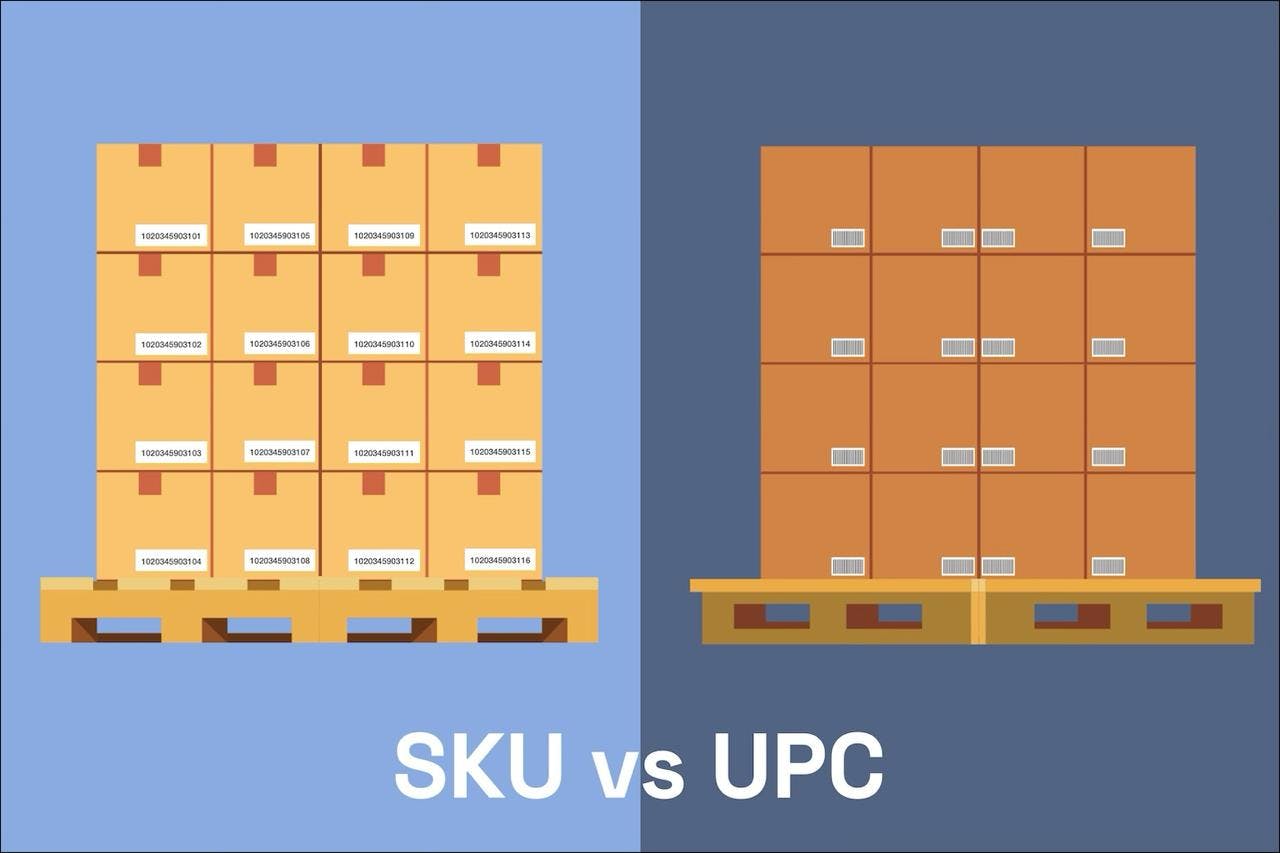
Last Mile Intelligence
May 21, 2025 - 4min read
ARTICLE
SKU vs UPC: Differences Explained and When to Use Each One
You’re uploading products, syncing inventory, or trying to print barcodes—and suddenly you're asked for a SKU… or is it a UPC?
It's easy to mix the two, and using the wrong one can lead to listing errors, mismatched stock, or fulfillment delays.
This guide breaks down the difference between SKU and UPC, so you can avoid confusion, stay organized, and get your product listings and inventory running smoothly.
UPC and SKU Overview
Before we go into the difference, let's first cover what these two are in an overview — so you’ll have a clear understanding of how SKUs and UPCs function in product tracking and inventory management.
What is a UPC?
A Universal Product Code (UPC) is a 12-digit numeric barcode used globally to identify products.
Managed by GS1, a nonprofit organization, UPCs ensure consistent product identification across various retailers and supply chains.
Each UPC is unique to a specific product and its variations, facilitating accurate tracking and sales processing.
Key Characteristics:
- Standardized Format: Consists of 12 numeric digits, ensuring uniformity across all products.
- Global Uniqueness: Each UPC is unique worldwide, preventing duplication and confusion in product identification.
- Manufacturer Identification: The first part of the UPC identifies the manufacturer, assigned by GS1.
- Product Identification: The subsequent digits specify the individual product.
- Check Digit: The final digit is a check digit, used to verify the accuracy of the UPC.
- Scannable Barcode: UPC barcodes are easily scannable at points of sale, streamlining the checkout process.
- Essential for Retail: Required for selling products through major retailers and online marketplaces.
What is an SKU?
A Stock Keeping Unit (SKU) is an alphanumeric code created internally by businesses to identify and track their products.
Unlike UPCs, SKUs are not standardized and can be customized to include information relevant to the company's inventory management needs, such as product type, size, color, or other attributes.
Key Characteristics:
- Customizable Format: SKUs can vary in length and composition, often incorporating letters and numbers that convey specific product details.
- Internal Use: Primarily used within a company for inventory tracking, sales analysis, and stock management.
- Unique per Company: Each SKU is unique within a company but may not be unique across different businesses.
- Reflects Product Attributes: SKUs often encode information such as product category, size, color, or other distinguishing features.
- Facilitates Inventory Management: Helps businesses monitor stock levels, manage reordering, and analyze sales performance effectively.
- Not Required for External Sales: Unlike UPCs, SKUs are not mandatory for selling products through external retailers but are beneficial for internal operations.
UPCs and SKUs each play a key role in helping you track and manage products more efficiently.
What’s the Difference Between SKU and UPC?
UPC and SKU codes are often confused with one another, but they serve different purposes—one is global and universal... the other is local and internal. Let’s break it down:

Purpose and Use
A UPC (Universal Product Code) is used for external identification. It’s what retailers, marketplaces like Amazon, or point-of-sale systems scan to retrieve product information. If you’re selling through third-party channels, you need a UPC so that your product is universally recognized.
A SKU (Stock Keeping Unit), on the other hand, is used internally. It helps you and your team track inventory, sales trends, reorder points, and variations within your product catalog. It’s more about your workflow than the customer’s checkout experience.
Think of a UPC as your passport to the retail world… and an SKU as your company’s personal filing system.
Format and Structure
UPC codes are always 12-digit numeric codes. They’re standardized, meaning no matter where a product is sold, its UPC remains the same. The format cannot be changed, and you must register it through GS1.
SKUs, in contrast, are alphanumeric and fully customizable. You can include codes for color, size, category, season, or warehouse location — whatever matters to your team. For example, JCK-BLK-LG-W23 could stand for a large black jacket from the Winter 2023 collection.
Basically: UPC = fixed and regulated. SKU = flexible and personalized.
Who Creates It
UPC codes are created by GS1 (a global standards organization). You need to pay to license them and follow a global system that ensures your product code doesn’t conflict with anyone else’s.
SKUs are made by you. You don’t need approval, registration, or fees. Every business can have its own SKU system depending on what details matter most operationally.
Where They’re Used
A UPC is used in retail stores, eCommerce sites, warehouses, shipping hubs — basically, any place where a product is scanned for identification or tracking outside your business. Think checkout scanners, Amazon listings, or Walmart fulfillment centers.
A SKU is used inside your business — your POS system, warehouse database, or order management software. It’s what your staff will use to look up product variants, check stock levels, or process returns.
Barcoding
UPC codes come with a barcode — it’s part of the package. That’s how UPCs are meant to be used: to be scanned at scale, instantly and consistently.
SKUs can be turned into barcodes, but they don’t automatically come with one. If you want to barcode your SKUs (like for scanning in your warehouse), you’ll need to generate the barcode yourself using software or a POS system.
Global vs. Local Uniqueness
UPCs are globally unique. No two products — anywhere in the world — can have the same UPC if they’re registered properly through GS1.
SKUs are unique only within your company. Two different stores might use the exact same SKU code for completely different products, and that’s perfectly fine — because SKUs are never meant to be shared across businesses.
Can a Product Have Both a SKU and a UPC?
Yes, and in fact, it’s common. Most businesses assign a SKU for internal tracking and use a UPC for external sales.
For example, a product may have a UPC like 012345678905 for use in online marketplaces and a SKU like TSH-BLU-LRG for use in your inventory system.
Both serve different functions but point to the same item.
When to Use Either SKU or UPC
Using SKUs or UPCs — or both — depends on where and how you sell. Here’s how to choose based on your setup and needs.
When to Use SKU
SKUs are best used for internal management and operational tracking.
They give your team detailed product-level info that helps you stay organized, avoid mistakes, and optimize workflows.
You sell product variations
SKUs help track different sizes, colors, or types.
You handle inventory yourself
Great for organizing stock in-house or in a small warehouse.
You want flexible product labeling
SKUs can follow your own naming system.
You don’t need barcodes or retail integration
Ideal if you're not selling through big marketplaces.
You use tools that support SKUs
Most POS and inventory systems let you manage SKUs easily.
If you're handling fulfillment or delivery in-house, tools like Carriyo’s Shipping Automation can help you streamline SKU-based workflows and ensure everything moves smoothly from warehouse to doorstep.
When to Use UPC
UPCs are designed for external product identification.
You’ll need UPCs if you’re listing your product on third-party platforms or need standardized barcodes that work across the supply chain.
You sell on Amazon, Walmart, or eBay
These platforms require UPCs to list and track products.
Retailers or distributors carry your products
UPCs let them scan and manage your items accurately.
You're scaling to more markets
UPCs support retail, multi-channel, and international growth.
You need reliable barcodes
UPCs are standardized and always come with a scannable barcode.
You want to prevent product mix-ups
UPCs are globally unique, avoiding confusion across sellers.
Systems like Carriyo’s Carrier Management and Last-Mile Intelligence rely on clean, scannable UPCs to ensure your products are delivered accurately and efficiently.
Conclusion
Getting SKUs and UPCs right isn’t just about labeling—it’s about keeping your operations clean, efficient, and ready to scale.
If you're looking to go beyond the basics and build a more connected logistics workflow, tools like our Shipping Automation and Carrier Management can help you manage everything from internal SKUs to marketplace-ready UPCs.
For businesses focused on delivery accuracy and branded customer experiences, Customer Experience and Last-Mile Intelligence can turn logistics into a competitive advantage.
No matter where you are—scaling a small business, growing an eCommerce brand, managing retail operations, or handling fulfillment as a 3PL or enterprise—Carriyo has the tools to help.
Best of luck with organizing your product catalog, and if you’re ready to streamline how everything moves from shelf to doorstep, explore more on our blog or get in touch with us.
FAQs
Do I need a UPC if I already have SKUs?
Only if you're selling on marketplaces like Amazon or Walmart. For internal use or POS systems, SKUs are usually enough.
Can I use the same SKU for multiple products?
No — each product and variation should have a unique SKU to avoid inventory errors.
Can I convert my SKUs into barcodes?
Yes, SKUs can be turned into scannable barcodes for internal use, but they won’t replace UPCs on external platforms.
Are UPCs reused or recycled?
No — once a UPC is assigned by GS1, it stays tied to that product permanently.
Is an ASIN the same as a UPC or SKU?
No — ASINs are Amazon-only identifiers, while UPCs and SKUs are provided by you.
01

Joao Vieira
CRO at CARRIYO
Product Assortment Guide: Characteristics, Examples, and More.
May 30, 2025 - 4min read
02

Joao Vieira
CRO at CARRIYO
Retail Logistics Guide: Definition, Types, and How to Set It Up
May 29, 2025 - 3min read
03

Joao Vieira
CRO at CARRIYO
SKU Rationalization: Definition, Importance, and Full Guide
May 28, 2025 - 3min read
Automate shipping operations and elevate post-purchase customer experience
We're trusted by

